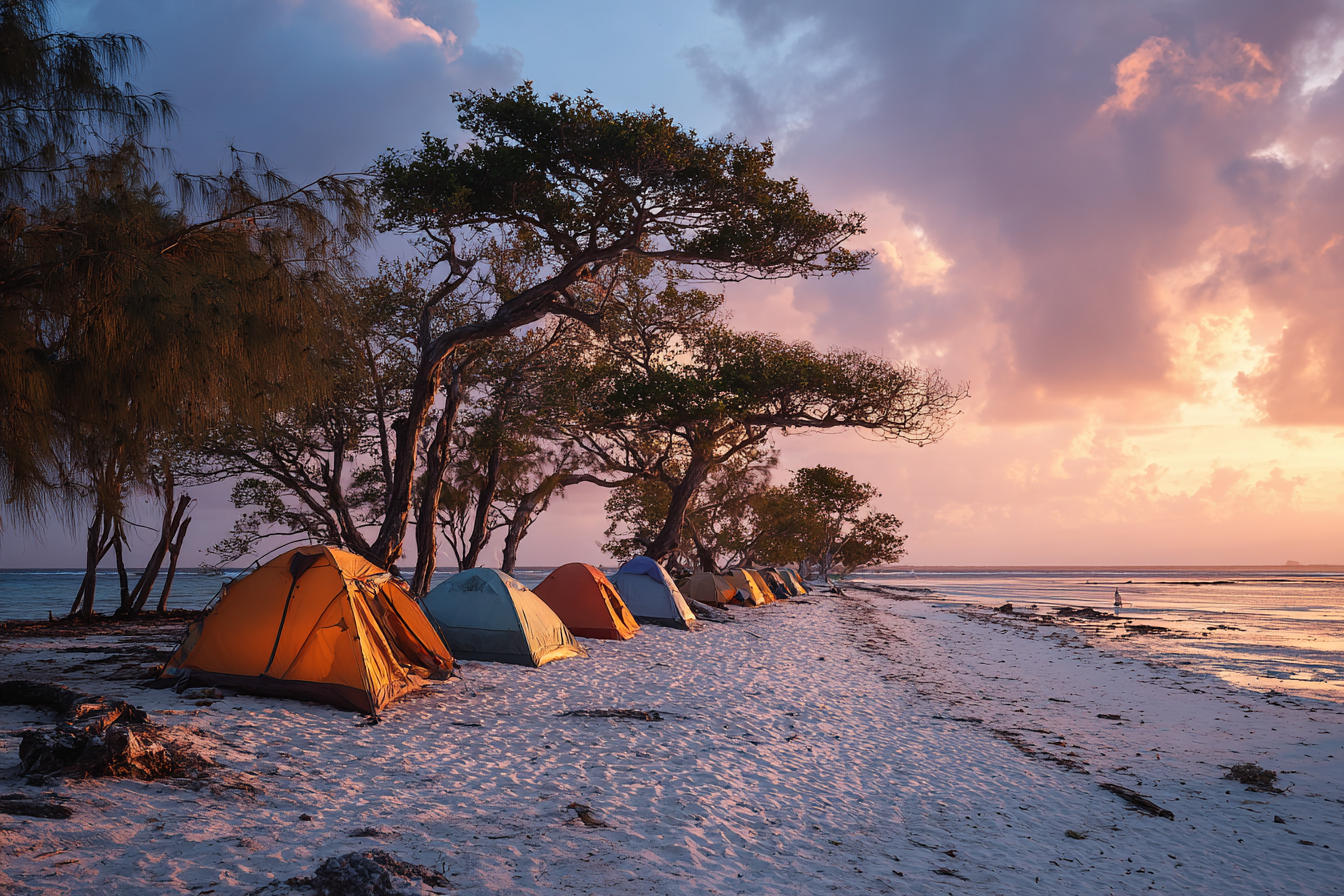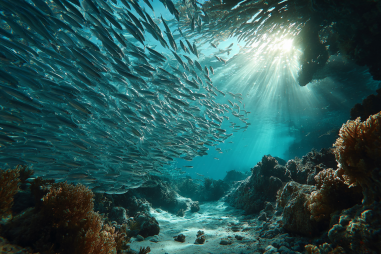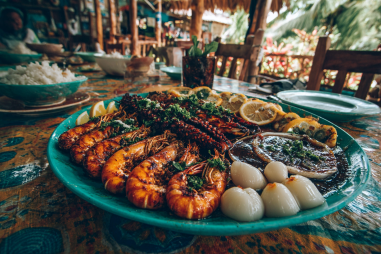Camping on a pristine island beach is a dream for many outdoor enthusiasts, and Kalanggaman Island in the Philippines offers just that—a breathtakingly beautiful spot where turquoise waters and powdery white sands meet under the open sky. This tiny island, famous for its long sandbar stretching into crystal-clear waters, is an ideal place to disconnect, immerse yourself in nature, and enjoy a unique camping experience by the beach. Whether you’re a seasoned camper or a first-timer, Kalanggaman Island provides an unforgettable backdrop for your next adventure.
Camping Rules and Regulations
To ensure the natural beauty and peaceful environment of Kalanggaman Island are preserved for everyone to enjoy, there are several important rules and regulations campers must follow. The island is managed by local authorities who strictly regulate camping activities to minimize environmental impact and maintain safety.
First and foremost, camping permits are required, which can be obtained through the local tourism office or through accredited tour operators. It’s important to apply in advance, especially during peak seasons, as the number of campers is limited to protect the island’s fragile ecosystem.
Campers are also prohibited from bringing any plastic items that can pollute the surroundings. Single-use plastics, glass bottles, and any non-biodegradable trash must be avoided. Camping fires are generally not allowed to prevent fire hazards and preserve the island’s natural state. Instead, campers are encouraged to use portable stoves or pre-cooked meals.
Noise levels should be kept minimal, especially during nighttime hours, to maintain a serene environment for all visitors and local wildlife. Furthermore, fishing and collecting marine life are forbidden to protect the island’s rich biodiversity.
What to Bring for Camping
Preparing for your Kalanggaman Island camping adventure requires thoughtful packing since the island is a remote destination with very limited facilities. Here’s a handy checklist of must-have items to keep your trip safe, comfortable, and eco-friendly:
- Tent: Compact, lightweight, and waterproof tents are essential to set up your camping space.
- Sleeping Gear: Sleeping bag or lightweight blankets, and sleeping mats or inflatable pads for comfort.
- Food and Water: Bring sufficient drinking water—at least 3 to 4 liters per person per day—and non-perishable, easy-to-cook meals. Portable stoves or camping burners are helpful.
- Cooking Supplies: Lightweight cooking utensils, reusable plates and cutlery, and eco-friendly cleaning materials.
- Sun Protection: Sunscreen, hats, sunglasses, and lightweight, long-sleeved clothing to protect against UV rays.
- Lighting: Headlamps or flashlights with extra batteries to navigate after sunset.
- First Aid Kit: Include essentials such as bandages, antiseptic, pain relievers, and insect repellent.
- Garbage Bags: To responsibly pack out all waste and keep the island clean.
- Miscellaneous: Swimwear, snorkeling gear, towels, camera, and a power bank for charging devices.
Setting Up Camp on the Island
Once you arrive at Kalanggaman Island, finding the perfect campsite is both exciting and important for your comfort and safety. The island’s sandbar is a popular spot offering unparalleled views, but it’s vital to set up your tent above the high tide line to avoid the risk of flooding overnight.
Look for a flat, shaded area near the coconut trees, which provide natural shade and shelter from the wind. Avoid disturbing vegetation or wildlife habitats while pitching your tent. Setting up your camp efficiently will help you relax and enjoy the beauty of the island throughout your stay.
Since electricity isn’t available, organize your gear so that essentials are easily accessible, and always keep your campsite tidy to prevent attracting insects or animals. Establish a designated spot for cooking and cleaning to minimize your footprint on the environment.
Activities to Enjoy While Camping
Kalanggaman Island is teeming with natural wonders and activities that make your camping trip unforgettable. Here are some highlights you shouldn’t miss:
- Swimming and Snorkeling: Explore the vibrant coral reefs and marine life surrounding the island. The clear, shallow waters make snorkeling accessible and enjoyable for all skill levels.
- Island Hopping: Join tours to nearby islands and beaches to experience different sceneries and marine ecosystems.
- Beachcombing and Shell Collecting: Walk along the long sandbar and shores to discover unique shells and marine treasures—just remember to admire and not take live souvenirs.
- Photography: Capture the stunning sunrises, sunsets, and starry night skies, which make perfect backdrops for memorable photos.
- Fishing (Catch and Release): While fishing for consumption is restricted, some visitors enjoy catch and release fishing with proper care to the marine life.
- Relaxation and Stargazing: Simply unwind on the beach, soaking in the tranquil atmosphere and marveling at constellations far from city lights.
Safety and Weather Considerations
Camping on an island requires being mindful of safety and weather conditions. Kalanggaman Island is located in a tropical region, so it’s important to plan your visit during the dry season, typically from November to May, when the weather is more predictable and sea conditions are calmer.
Strong winds, tropical storms, and typhoons can occur outside this period, making sea travel risky and potentially dangerous. Always check local weather forecasts before your trip and heed warnings from authorities.
Marine hazards such as strong currents or jellyfish may appear occasionally, so swim cautiously and avoid venturing too far into the sea alone. Inform someone about your plans and always camp with a companion for extra security.
Additionally, be cautious with food storage to prevent attracting insects or animals, and drink plenty of water to stay hydrated in the tropical heat.
Leave No Trace Principles
Preserving Kalanggaman Island’s natural beauty is a shared responsibility. Practicing Leave No Trace principles helps ensure the island remains pristine for future visitors and supports local conservation efforts.
Here are key guidelines to adhere to:
- Pack Out What You Pack In: Bring all your trash back with you; never leave litter behind.
- Respect Wildlife: Observe animals from a distance without disturbing or feeding them.
- Minimize Campfire Impacts: Use portable stoves instead of campfires to avoid damaging the environment.
- Stay on Established Paths: Avoid trampling vegetation by sticking to designated trails and campsites.
- Dispose Waste Properly: Use designated restroom facilities if available or follow guidelines for waste disposal to protect water sources.
- Be Considerate of Others: Maintain low noise levels and respect other campers’ space and experience.
By following these principles, your Kalanggaman Island camping experience contributes to the sustainability of this beautiful destination.
Making Your Camping Trip Unforgettable
Camping on Kalanggaman Island offers a rare opportunity to connect deeply with nature, away from the distractions of everyday life. The tranquility of the island, the endless horizon of the sandbar, and the vibrant marine life all combine to create a magical setting for your outdoor adventure.
Whether you spend your days swimming, snorkeling, hiking, or simply reclining beneath the stars, the memories you make here will stay with you long after you leave. Careful planning, respectful behavior, and thoughtful preparation ensure that your trip is not only enjoyable but also contributes positively to preserving Kalanggaman Island’s fragile ecosystem.
So pack your gear, bring your sense of adventure, and get ready to experience beachfront camping in one of the Philippines’ most spectacular island paradises. Kalanggaman Island awaits to offer you a truly unforgettable camping journey surrounded by nature’s splendor.







